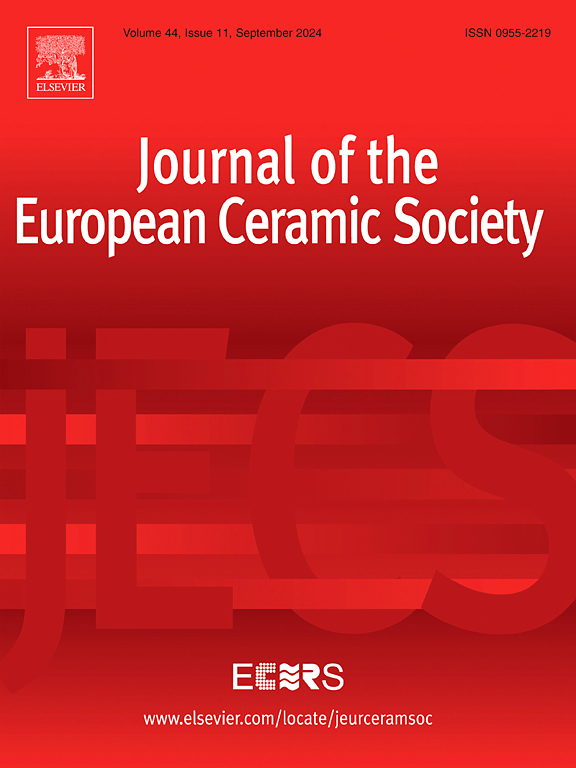振荡压力烧结制备BN-SiC复合材料的组织和综合性能
IF 6.2
2区 材料科学
Q1 MATERIALS SCIENCE, CERAMICS
Journal of The European Ceramic Society
Pub Date : 2025-06-10
DOI:10.1016/j.jeurceramsoc.2025.117618
引用次数: 0
摘要
在1800℃振荡压力烧结1 h制备了BN(40-70 wt%)和SiC(20-50 wt%)含量不同的BN-SiC复合材料。结果表明,B50S40Y10复合材料(BN / SiC =五4)达到94.65 %的相对密度,抗弯强度485.1 ±24.2 MPa,断裂韧性4.87 ±0.45 MPa·m1/2,和维氏硬度的4.78 ±0.18 GPa。这些增强归因于BN/SiC边界的应力诱导强化,以及BN介导的裂纹桥接和SiC诱导的裂纹挠曲的协同增韧机制。此外,富sic复合材料的耐磨性增强,磨损率降至(0.93-1.15)× 10−3 mm3·N−1 m−1,比富bn复合材料降低了约三分之二。这种减少归因于磨损机制从磨料为主到氧化为主的过渡。此外,由于在BN-SiC复合材料表面形成了Y2Si2O7/YBO3保护层,有效地抑制了氧扩散到块体材料中,从而表现出优异的抗氧化性能。本文章由计算机程序翻译,如有差异,请以英文原文为准。
Microstructure and comprehensive properties of BN-SiC composites fabricated via oscillatory pressure sintering
BN-SiC composites with varying BN (40–70 wt%) and SiC (20–50 wt%) contents were fabricated via oscillatory pressure sintering at 1800 °C for 1 h. The results indicate that the B50S40Y10 composites (BN/SiC=5:4) achieve a relative density of 94.65 %, flexural strength of 485.1 ± 24.2 MPa, fracture toughness of 4.87 ± 0.45 MPa·m1/2, and Vickers hardness of 4.78 ± 0.18 GPa. These enhancements are attributed to stress-induced strengthening at BN/SiC boundaries, as well as synergistic toughening mechanisms involving BN-mediated crack bridging and SiC-induced crack deflection. Additionally, SiC-rich composites exhibit enhanced wear resistance, with wear rate decreasing to (0.93–1.15) × 10−3 mm3·N−1 m−1, approximately two-thirds reduction compared to BN-rich composites. This reduction is attributed to a transition in the wear mechanism from abrasive-dominated to oxidation-dominated wear. Furthermore, BN-SiC composites display excellent oxidation resistance due to the formation of Y2Si2O7/YBO3 protective layers on their surface which effectively inhibits oxygen diffusion into the bulk material.
求助全文
通过发布文献求助,成功后即可免费获取论文全文。
去求助
来源期刊

Journal of The European Ceramic Society
工程技术-材料科学:硅酸盐
CiteScore
10.70
自引率
12.30%
发文量
863
审稿时长
35 days
期刊介绍:
The Journal of the European Ceramic Society publishes the results of original research and reviews relating to ceramic materials. Papers of either an experimental or theoretical character will be welcomed on a fully international basis. The emphasis is on novel generic science concerning the relationships between processing, microstructure and properties of polycrystalline ceramics consolidated at high temperature. Papers may relate to any of the conventional categories of ceramic: structural, functional, traditional or composite. The central objective is to sustain a high standard of research quality by means of appropriate reviewing procedures.
 求助内容:
求助内容: 应助结果提醒方式:
应助结果提醒方式:


